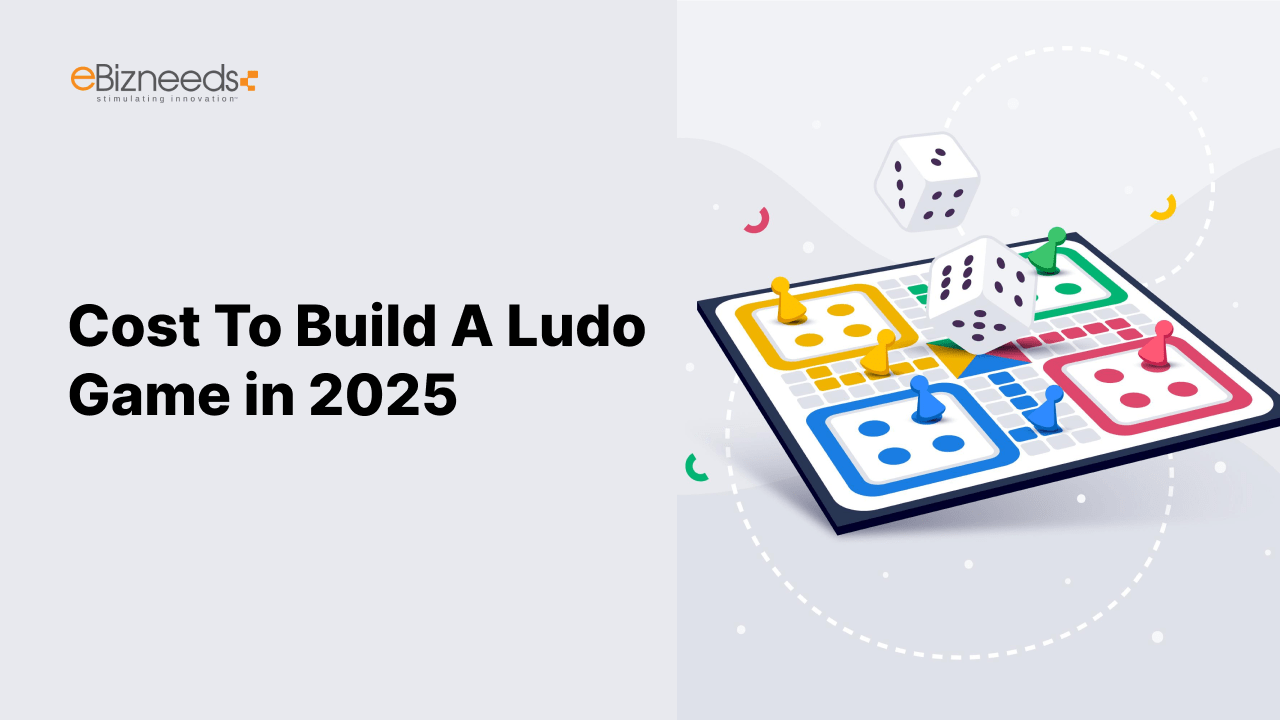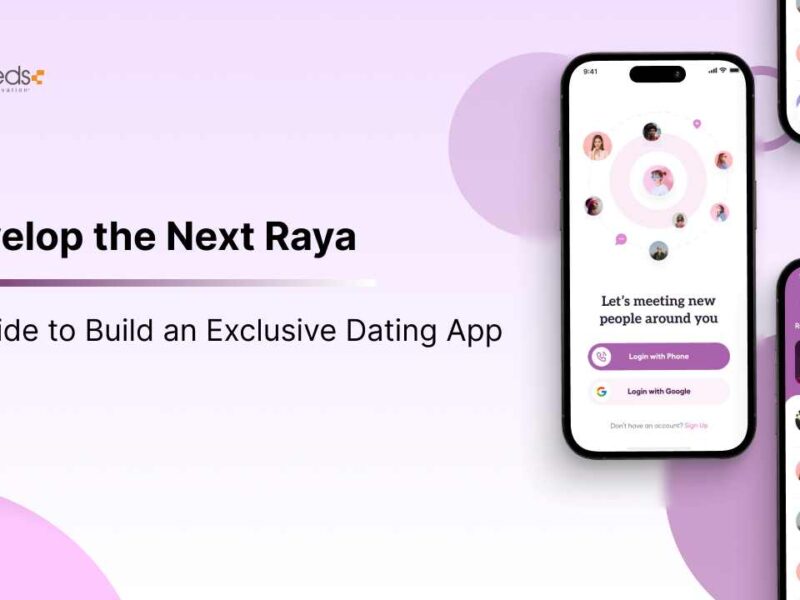Have you been thinking about the cost to develop Ludo game for your next business move?
It might surprise you to know that Ludo game development cost often ranges between $10,000 and $50,000, depending on your scope and features.
Yes, that’s a broad range. But don’t let that cloud your vision.
In the following sections, you’ll see exactly what goes into this process and how those figures take shape.
Ready to uncover the details? Let’s kick off by exploring why a Ludo game could be a strong choice for you.



Should You Develop A Ludo Game?
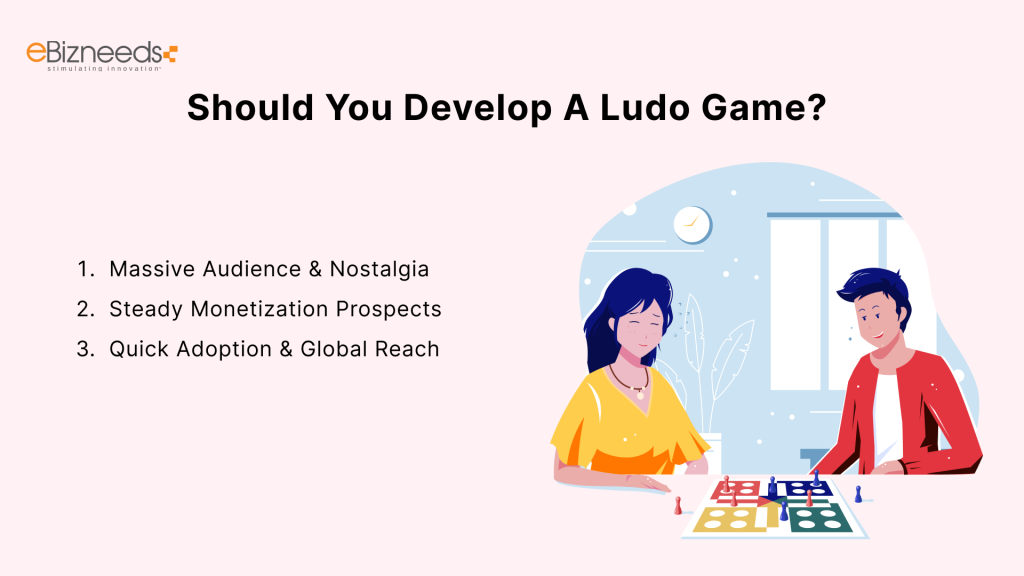


It’s easy to see why many businesses lean toward Ludo these days.
Reason 1: Massive Audience & Nostalgia
Ludo King surpassed 700 million downloads globally.
This timeless board-based concept stirs up warm, familiar memories, giving you a ready-made audience.
And when folks are already comfortable with the rules, they’re more likely to hit that “Play” button.
Reason 2: Steady Monetization Prospects
Beyond banner ads, many Ludo apps introduce in-app purchases for virtual coins, premium themes, or extra moves.
According to Statista, revenue in the board-game segment (Ludo included) has seen consistent growth, making it a worthwhile digital venture.
Reason 3: Quick Adoption & Global Reach
Online Ludo platforms have popped up everywhere, often trending in multiple countries.
That means you could attract users from all walks of life.
If you’re curious about how much does it cost to develop Ludo game, it’s worth noting that a broad audience base often helps recoup expenses more quickly.
So, are you ready to jump onto this rising trend?
If so, keep reading.
We’ll look at the average cost to make Ludo game and what factors shape that figure.
Average Cost to Develop Ludo Game
Wondering how much does it cost to develop Ludo game?
You’re not alone.
On average, if you plan to build Ludo game from scratch with standard features—like classic boards, simple graphics, and common multiplayer modes—you might be looking at $10,000 to $25,000.
Add in advanced elements such as live chat, multiple themes, or unique tournaments, and the cost to build Ludo game can jump to $40,000 or more.
Here’s a quick snapshot:
| Cost Range | Key Features | Estimated Timeline |
| $10,000 – $25,000 | Basic design, standard gameplay | 2–3 months |
| $25,000 – $40,000 | Advanced features (live chat, multiple modes) | 3–5 months |
| $40,000+ | Highly customized options, special tournaments | 5+ months |
Your final price tag depends on coding complexity, platform choices, and team size.
Even small tweaks—like custom avatars—can nudge up the cost to make Ludo game.
If your product stands out with user-friendly features and strong functionality, you’ll likely see more players returning.
Plus, a well-structured monetization model can help you recoup your Ludo game development cost in no time.
In short, you have options to start small or aim for the stars.
Either way, a well-thought-out plan helps ensure you don’t blow your budget.
So, keep your must-have features in mind, stay flexible with optional extras, and tailor your approach to fit your resources.
Factors That Affect Ludo Game Development Cost
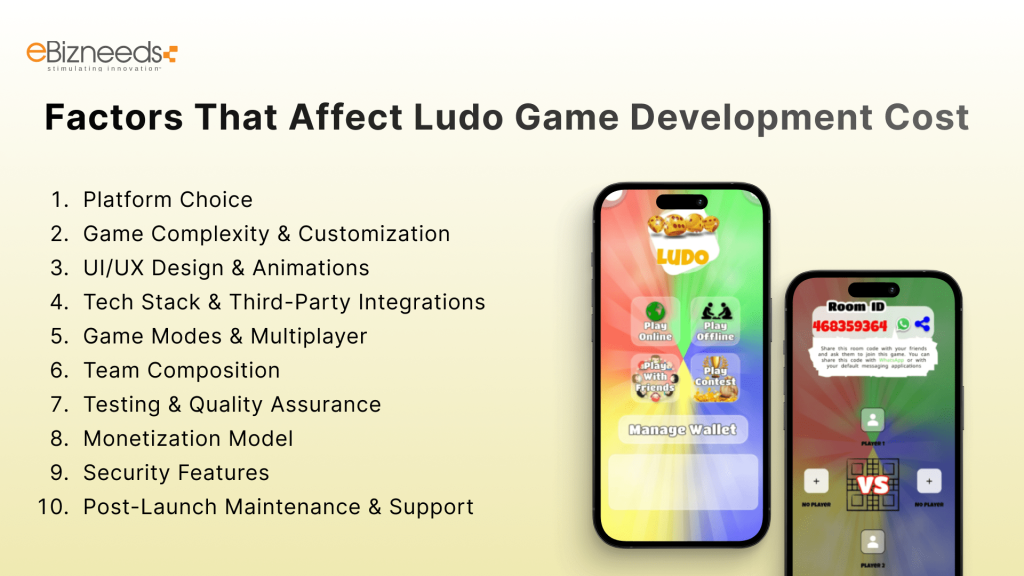


Ever found yourself scratching your head over why quotes for building Ludo game can vary so widely?
Sometimes it’s like trying to piece together a puzzle with missing corners.
Below, you’ll see ten key factors that play a big role in determining your overall Ludo game development cost.
We’ll also drop small tables for each factor—just a quick way to see how your decisions can raise or lower the final price tag.
Use these insights to plan how much does it cost to develop Ludo game without feeling overwhelmed.
1. Platform Choice
Is your plan to reach Android users only, or do you want iOS too?
Heck, maybe you’d like to launch on the web as well?
Different platforms often mean separate development tracks.
This can directly affect your cost to build Ludo game because you might need multiple versions and more testing hours.
| Platform Choice | Impact on Cost | Approx. Cost Addition |
| Single Platform | Less code duplication, simpler QA | $2,000 – $4,000 |
| Multiple Platforms | Separate or hybrid approach, extended testing | $5,000 – $8,000 |
| Web + Mobile | Web-based elements plus distinct mobile features | $7,000 – $10,000 |
2. Game Complexity & Customization
Want just the classic look, or do you have a bold new board layout in mind?
Your creativity might turn heads, but every unique feature adds more hours to your development cycle.
| Complexity Level | Key Add-Ons | Extra Cost Range |
| Basic (Classic) | Standard board, standard rules | $2,000 – $5,000 |
| Intermediate (Themes, Avatars) | Custom themes, unique tokens | $5,000 – $8,000 |
| Advanced (Special Game Modes) | Additional boards, special AI | $8,000 – $12,000 |
If you’re aiming to build Ludo game with exclusive modes, don’t be surprised if your total bill inches upward.



After all, every inch of personalization can demand more manpower and testing.
3. UI/UX Design & Animations
People love a slick layout.
But quality design is like good seasoning: you might not notice each detail, but it sure keeps you coming back.
Here’s a breakdown of UI/UX design cost:
| Design Complexity | What’s Included? | Added Cost |
| Minimalist | Simple icons, basic transitions | $1,000 – $3,000 |
| Moderate | Detailed graphics, smooth animations | $3,000 – $6,000 |
| High-End | Custom art, advanced animations, transitions | $6,000 – $10,000 |
If you crave eye-catching visuals that keep users playing, factor these numbers into your Ludo game development cost.
4. Tech Stack & Third-Party Integrations
Choosing your tech stack is like picking the right tools for a home renovation.
Whether you go for Unity, HTML5, or a custom engine, each has its own cost implications.
Then there are third-party APIs—like payment gateways or social media integrations—that can pop up as extra expenses.
| Tech Aspect | Impact on Cost | Cost Range |
| Simple Stack (Unity/HTML5) | Lower complexity, common libraries | $2,000 – $4,000 |
| Custom Engine/Advanced Plugins | Specialized expertise needed | $4,000 – $7,000 |
| Multiple Third-Party APIs | Payment systems, social login, analytics | $1,000 – $3,000 extra |
Does your vision include quick sign-ups via Facebook or Google?
That’s more code, more testing, and a bump in cost to make Ludo game that stands out.
5. Game Modes & Multiplayer
From classic solo play to thrilling multiplayer tournaments—variety spices up user engagement.
But adding real-time features can turn up the heat on development complexity.
| Game Mode | Impact on Cost | Cost Estimate |
| Single-Player Offline | Straightforward, basic AI | $1,000 – $3,000 |
| Local Multiplayer | Simple pass-and-play approach | $2,000 – $4,000 |
| Online Multiplayer | Real-time servers, matchmaking | $5,000 – $9,000 |
If you plan to build Ludo game that supports real-time interactions, set aside a generous slice of your budget.
6. Team Composition
Is it a small, tight-knit group or a larger, specialized crew?
Freelancers might appear budget-friendly at first, but consistent teams can offer smoother coordination.
| Team Setup | Advantages | Hourly Rate |
| Freelancers | Lower rates, flexible scheduling | $15 – $40 per hour |
| Local Agency | Strong collaboration, standard project roadmap | $40 – $70 per hour |
| Offshore Team | Potentially lower rates, requires clear oversight | $20 – $50 per hour |
Your choice directly shapes how much does it cost to develop Ludo game.
Pick wisely, and keep lines of communication open.
7. Testing & Quality Assurance
Nothing spoils the fun like constant crashes.
Quality testing keeps your players happy and fosters better reviews.
| Testing Scope | Coverage | Approx. Cost |
| Basic (Manual) | Checking core flows on fewer devices | $1,000 – $3,000 |
| Comprehensive (Manual + Automated) | Multiple device tests, automation suites | $3,000 – $7,000 |
| Beta Testing | External group tries real-world gameplay | $2,000 – $4,000 |
While you can trim testing to cut corners, thorough QA can save you headaches (and money) later.
8. Monetization Model
Will you rely on ads or in-app purchases?
Each monetization path requires extra modules, payment setups, or ad network integrations.
| Model | Revenue Approach | Added Cost |
| Ads Only | Banner/interstitial ads | $500 – $2,000 |
| In-App Purchases | Paid tokens, premium board themes | $2,000 – $5,000 |
| Hybrid | Mix of ads + in-app items | $2,500 – $6,000 |
A well-planned monetization structure can help you recover your Ludo game development cost faster.
9. Security Features
Online fraud and hacking attempts can hurt your app’s reputation.
Secure payment gateways, data protection, and encryption might sound tech-heavy, but they’re important.
| Security Level | Key Measures | Additional Cost |
| Basic Encryption | Secure database and transactions | $1,000 – $2,000 |
| Multi-Factor Authentication | Adds OTP or biometric security | $2,000 – $4,000 |
| Advanced Anti-Cheat Mechanisms | Real-time tracking to prevent cheating | $2,500 – $5,000 |
Why let hackers spoil the party?
A pinch of prevention can save big bucks in the long run.
10. Post-Launch Maintenance & Support
Once you publish, the journey isn’t over.
This is time to start maintenance.
Updates, bug fixes, and additional content can keep your game fresh but also require consistent funding.
| Maintenance Scope | Coverage | Monthly Cost |
| Basic Support | Minor bug fixes, stability checks | $500 – $1,000 |
| Medium-Level Maintenance | Regular updates, new minor features | $1,000 – $2,000 |
| High-Level Maintenance | Frequent updates, major feature rollouts | $2,000 – $4,000 |
If you’re wondering how much does it cost to develop Ludo game and keep it thriving, don’t forget these ongoing fees.
These factors aren’t meant to scare you off.
Instead, think of them as a roadmap—helping you see where your dollars might go.
When you keep your eye on these elements, you’ll have a better sense of your cost to make Ludo game that meets your business goals.



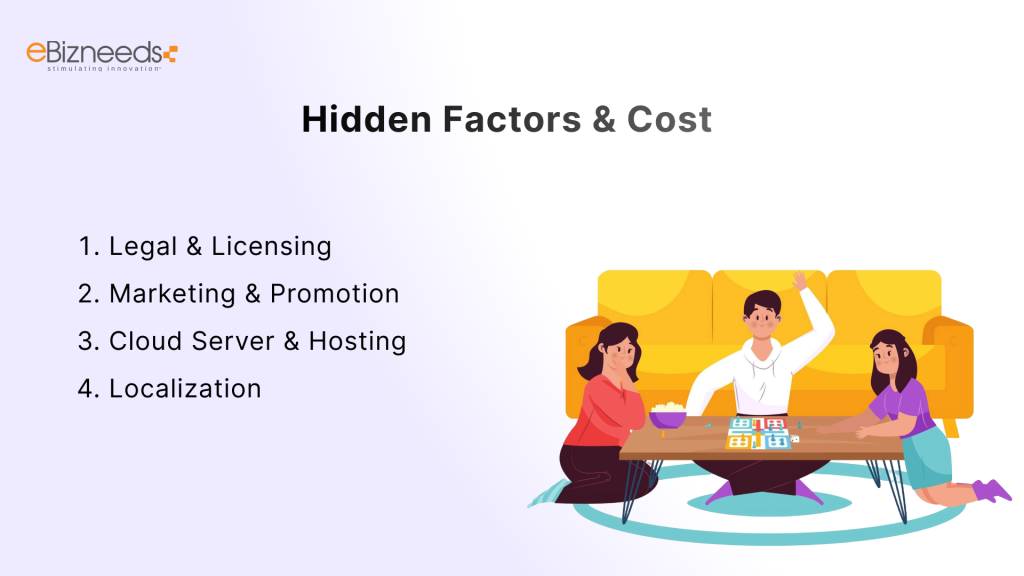


Sometimes, there are costs lurking beneath the surface—those little extras that can catch you off guard.
Below, we’ll explore a few hidden factors that may sway your final Ludo game development cost.
Don’t let these surprises throw a wrench in your budget. Instead, factor them in from the start, and you’ll sleep better at night!
1. Legal & Licensing
Depending on your region, you may need specific licenses or authorizations.
In some cases, local regulations can affect how you structure certain in-game transactions.
| Aspect | Potential Requirements | Approx. Cost |
| Gaming License | Region-based permits, tax obligations | $1,000 – $3,000 |
| Intellectual Rights | Trademark checks, original content reviews | $500 – $2,000 |
If you’re aiming to build Ludo game for international markets, thorough research on legal steps is vital.
After all, better safe than sorry.
2. Marketing & Promotion
You’ve built a fantastic product—how do you get folks to notice it?
Budgeting for marketing helps your app reach the right audience and generate momentum.
| Marketing Level | Approach | Estimated Spend |
| Basic Social Push | Organic posts, small ads | $1,000 – $3,000 |
| Influencer Tie-Ins | Partnerships, reviews | $3,000 – $6,000 |
| Broad Campaign | Multiple ad channels | $6,000 – $10,000+ |
Failing to promote your game can lead to a slow adoption rate, which affects your cost to develop Ludo game recovery time.
3. Cloud Server & Hosting
Think real-time matchmaking, global accessibility, and stable gameplay.
All of that demands reliable hosting.
| Hosting Option | What It Offers | Monthly Cost |
| Shared Hosting | Basic capacity, limited load | $50 – $100 |
| Dedicated Server | Higher load support, better performance | $150 – $300+ |
| Cloud Services (AWS/Azure) | Scalable on-demand, global reach | $300 – $700+ |
If you plan to handle thousands of players at once, brace yourself for a bigger tab.
But a stable infrastructure can keep folks coming back for more.
4. Localization
Planning to reach diverse markets?
Translating your game into multiple languages can boost user satisfaction, but also adds costs.
| Localization Scope | Coverage | Extra Cost |
| Single Language | Simple text translations | $500 – $1,000 |
| Multiple Languages | Text + cultural adjustments | $1,000 – $3,000+ |
| Continuous Updates | Ongoing translation for new features | $500 – $1,000/month |
When you wonder how much does it cost to develop Ludo game for a global audience, keep localization on your radar.
These hidden elements might not appear front and center, but they can definitely shape your cost to build Ludo game.
By planning for them early, you’ll avoid unexpected financial hits.
After all, a well-prepared approach can save you both time and stress as you make Ludo game that truly meets user expectations.
Popular Ludo Games & Cost To Clone Them
Ever toyed with the idea of cloning a smash-hit Ludo app?
Sometimes, following in the footsteps of proven winners can be a savvy move.
Below, you’ll see ten names that often trend on U.S. charts and beyond.
We’ll also drop a rough price tag to develop a Ludo game like each one.
| Popular Ludo Game | Notable Features | Approx. Cloning Cost |
| 1. Ludo King | Real-time multiplayer, voice chat | $40,000 – $60,000 |
| 2. Ludo Club | Fast gameplay, minimalistic design | $35,000 – $55,000 |
| 3. Ludo Talent | Custom avatars, daily rewards | $30,000 – $50,000 |
| 4. Ludo All Star | Tournaments, regional rooms | $40,000 – $60,000 |
| 5. Ludo Party | Simple UI, offline play modes | $25,000 – $45,000 |
| 6. Parchisi Star Online | Classic Spanish variant, cross-platform | $40,000 – $60,000 |
| 7. Ludo Fantasy | 3D animations, quick matchmaking | $35,000 – $55,000 |
| 8. King of Ludo | Multiple board themes, lively sound effects | $30,000 – $50,000 |
| 9. Ludo Supremo | Customizable tokens, social media integration | $25,000 – $45,000 |
| 10. Ludo Master | Built-in chat, weekly competitions | $35,000 – $55,000 |
Each cost range covers planning, design, coding, testing, and launch.
But keep in mind that unique branding or added bells and whistles will push the overall Ludo game development cost upward.
If you’re wondering how much does it cost to develop Ludo game at the level of these big players, give yourself room to maneuver in your budget.
That way, you can adapt on the fly if you decide to include advanced features.
After all, sometimes you gotta strike while the iron’s hot!
By the time you’ve cloned your favorite hit, you’ll have spent a decent sum—yet if done right, you’ll stand a better chance of recouping your cost to build Ludo game sooner.
Here’s How To Minimize Development Cost
You might be ready to build Ludo game but not ready to see your budget skyrocket.
Don’t worry—here are a few ways to lower your total Ludo game development cost without giving up on quality.
1. Start with a Minimum Viable Product (MVP)
An MVP lets you focus on essential features—basic gameplay, stable connections—so you can launch quickly.
It helps you gather real user feedback before spending more time (and money) on advanced bells and whistles.
How Much Can You Save?
Cutting out non-critical frills can shave off $3,000–$7,000 right away.
2. Use Existing Modules & Frameworks
Using pre-built libraries or engines (like Unity) can slice your development hours significantly.
Why reinvent the wheel if a tried-and-tested foundation is already available?
How Much Can You Save?
Expect 15%–20% off your total cost to develop Ludo game in many cases.
3. Maintain Clear Communication
A lot of back-and-forth can lead to confusion and repeated work.
Keeping everyone on the same page—developers, designers, testers—ensures you don’t sink cash into unnecessary revisions.
How Much Can You Save?
A well-coordinated approach might trim $2,000–$5,000 from your cost to make Ludo game.
4. Plan Updates Strategically
Sure, updates and new features keep your audience happy.
But constantly pushing changes can inflate your cost to build Ludo game.
Consider batching improvements in phases.
How Much Can You Save?
You could knock off 10% of monthly development costs by rolling out upgrades at measured intervals.
5. Outsource Smartly
Working with an offshore team can be economical—provided you do your homework.
Look for a vendor with a proven track record rather than just the lowest bid.
How Much Can You Save?
Sometimes, you can see a reduction of 20%–30% in labor costs, especially for specialized tasks.
6. Leverage Cloud Services Wisely
Cloud-based hosting can expand or shrink depending on your user base, so you’re only paying for what you need.
That flexibility keeps your monthly bills in check.
How Much Can You Save?
A scalable setup may cut server expenses by $100–$200 a month, depending on traffic.
By focusing on these methods, you’ll have a better shot at building a solid Ludo app while avoiding massive bills.
After all, when you handle your money wisely, you’ll feel more at ease putting your plans into motion.
eBizneeds – Here To Help You
At eBizneeds, we deliver streamlined Ludo game experiences designed to fit your budget.
Our team stands ready to handle each phase, from concept design and platform selection to launch and updates.
With decades of expertise, we follow proven methods and keep you in the loop at every turn.
Our flexible pricing models help you trim costs while still offering a high-quality app your players will enjoy.
Looking for a software development company, that truly aligns with your vision?
We’re here to guide you, ensuring your cost to build Ludo game remains within your limits—without cutting corners.



Conclusion
At the end of the day, venturing into the world of Ludo opens up a colorful path for entrepreneurs and game enthusiasts alike.
From basic builds to high-end masterpieces, your Ludo game development cost will shift depending on the scope, features, and ongoing support you choose.
The good news?
You can shape your journey to match both your vision and your wallet.
Keep your eyes peeled for the biggest cost influencers—like features, tech stack, and marketing—and you’ll be well on your way to creating a standout experience for your audience.
FAQs
It can range from $10,000 to well over $40,000.
Your target platforms, custom features, and design depth affect the total price tag.
Some titles add advanced items—think real-time chat or specialized tournaments.
These extras naturally raise the overall Ludo game development cost.
If you have the funds and aim for a broader user base, yes.
Otherwise, begin with one platform and expand later to control the cost to build Ludo game.
It can take anywhere from 3 to 6 months, sometimes more.
Complex animations, live multiplayer, and heavy testing all impact timelines.
A sleek interface with custom themes may drive up cost to make Ludo game.
Yet it can also enhance user retention, which boosts your revenue prospects.
Monetization avenues like ads, in-app buys, or premium modes can help.
A well-chosen strategy often accelerates your return on investment.
Ongoing updates keep your user community happy. That’s an added monthly or quarterly expense but helps protect your original cost to develop Ludo game by extending its life cycle.
Many choose an MVP approach, then grow feature sets as revenue allows.
This strategy helps manage your initial development costs more comfortably.



Udai Singh Shekhawat is the SEO Content Strategist and team lead at eBizneeds, with deep expertise in fintech and eWallet app development. He crafts result-oriented content strategies tailored for Western and Australian markets, driving impactful brand engagement and user acquisition through innovative storytelling and industry-specific insights.
